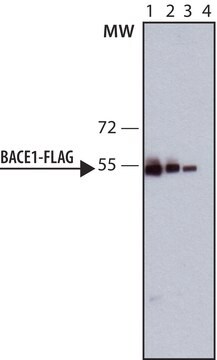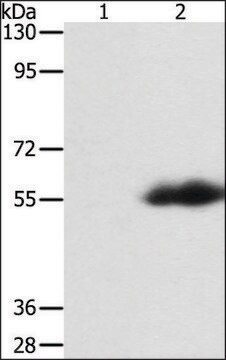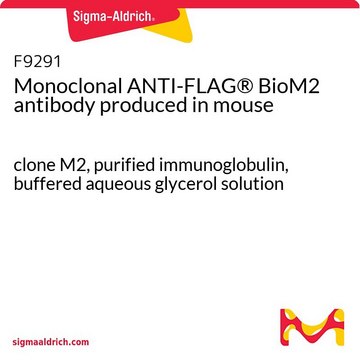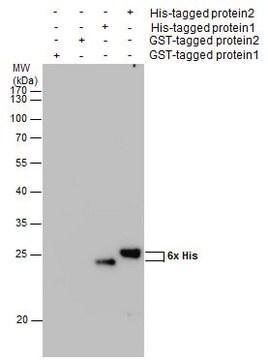Kluczowe dokumenty
H7425
Anti-FLAG®-Peroxidase antibody produced in rabbit
IgG fraction of antiserum
Synonim(y):
Anti-FLAG-HRP Polyclonal Conjugate
About This Item
Polecane produkty
Poziom jakości
opis
buffered aqueous solution
Formularz
lyophilized solid
metody
western blot: 1:2000-1:4000 using for detection of amino-terminal FLAG-BAP fusion protein in an E. coli crude cell lysate
Warunki transportu
dry ice
temp. przechowywania
−20°C
Opis ogólny
ANTI-FLAG recognizes the FLAG epitope located on FLAG fusion proteins. The antibody reacts with N-terminal, N-terminal-Met, and C-terminal FLAG fusion proteins by immunoblotting. Specific staining is inhibited by the FLAG peptide (N-Asp-Tyr-Lys-Asp-AspAsp-Asp-Lys-C). Applications for the conjugate include Western blots and ELISA.
Epitope tags provide a method to localize gene products in a variety of cell types, study the topology of proteins and protein complexes, identify associated proteins, and characterize newly identified, low abundance, or poorly immunogenic proteins when protein specific antibodies are not available. Tagging with the FLAG peptide sequence may be done at the N-terminus, N-terminus preceded by a methionine residue, C-terminus, or at internal positions of the target protein. FLAG may also be placed in association with other tags. The small size of the FLAG tag or sequence and its high hydrophilicity tend to decrease the possibility of interference with the protein expression, proteolytic maturation, antigenicity, and function. The N-terminal FLAG peptide sequence contains a unique enterokinase cleavage site allowing it to be completely removed from the purified fusion proteins. Cleavage catalyzed by Cu2+ ions of the C-terminal FLAG peptide from a fusion protein has been reported. A sequence motif with five out of eight amino acid residues identical to the FLAG peptide is found in both rat and mouse Mg2+ dependent protein β-phosphatase, as well as in the human and bovine enzyme.
Immunogen
Zastosowanie
Browse additional application references in our FLAG® Literature FLAG® Literature portal.
Postać fizyczna
Informacje prawne
Oświadczenie o zrzeczeniu się odpowiedzialności
Hasło ostrzegawcze
Danger
Zwroty wskazujące rodzaj zagrożenia
Zwroty wskazujące środki ostrożności
Klasyfikacja zagrożeń
Aquatic Chronic 3 - Eye Irrit. 2 - Resp. Sens. 1 - Skin Irrit. 2 - Skin Sens. 1
Kod klasy składowania
11 - Combustible Solids
Klasa zagrożenia wodnego (WGK)
WGK 3
Wybierz jedną z najnowszych wersji:
Certyfikaty analizy (CoA)
Przepraszamy, ale COA dla tego produktu nie jest aktualnie dostępny online.
Proszę o kontakt, jeśli potrzebna jest pomoc Obsługa Klienta
Masz już ten produkt?
Dokumenty związane z niedawno zakupionymi produktami zostały zamieszczone w Bibliotece dokumentów.
Nasz zespół naukowców ma doświadczenie we wszystkich obszarach badań, w tym w naukach przyrodniczych, materiałoznawstwie, syntezie chemicznej, chromatografii, analityce i wielu innych dziedzinach.
Skontaktuj się z zespołem ds. pomocy technicznej









